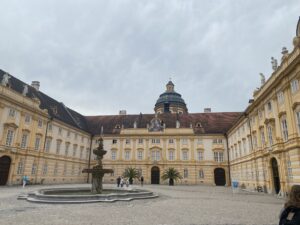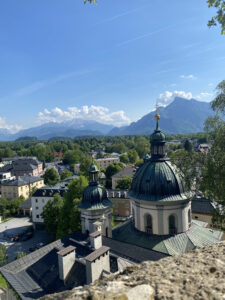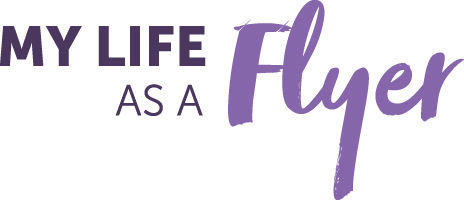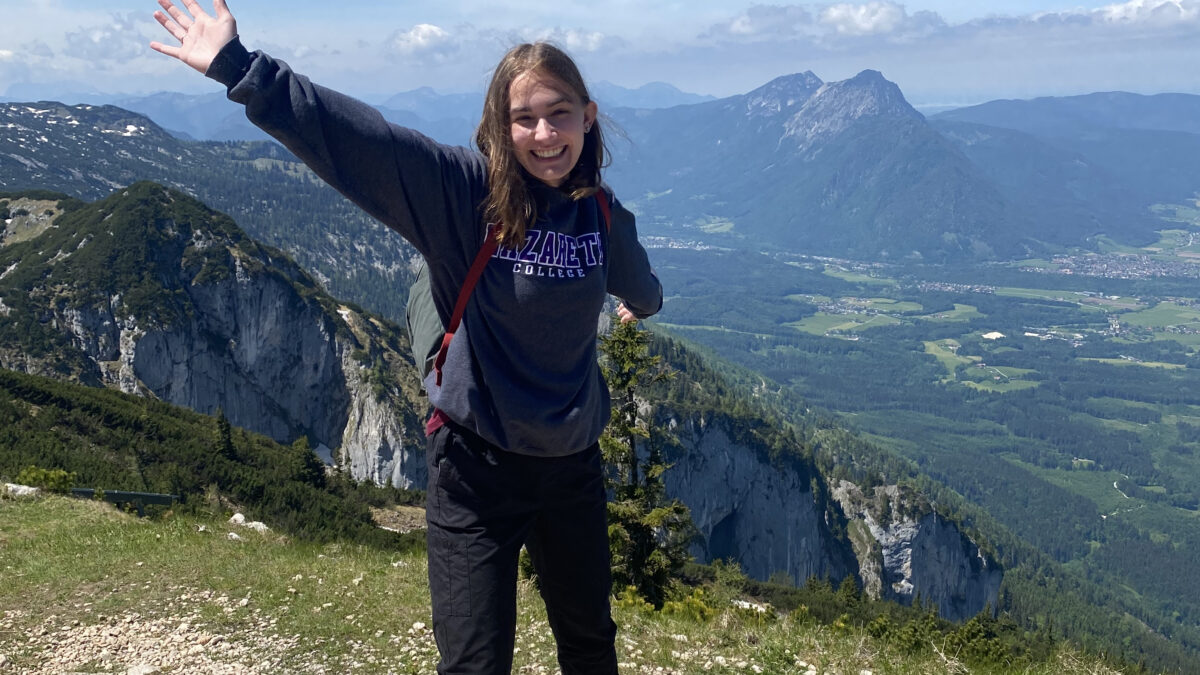For the first three weeks of my summer, I studied abroad alongside 11 other Nazareth College music students enrolled in the Music & Culture in Austria course, which is taught by Nazareth professor Dr. Marjorie Roth and Austrian musicologist Dr. Michael Malkiewicz. Throughout the course, we traveled across Austria, to Salzburg, Melk, Vienna, and the town of Kremsmünster to study the musical and cultural history of the country. I had wanted to take this course since I became aware of it during my freshman year at Naz, but it was especially meaningful for me to be a part of this class as I had initially planned on taking it during the summer of 2020, which of course didn’t happen. With the continuing uncertainty of the pandemic and global conflicts during this past year, I was unsure if I would get to do this class on my second try. It wasn’t until the morning of May 14th, when I woke up early to finish moving out of my apartment, attended my graduation ceremony at Naz, and threw my remaining belongings into my suitcase that it hit me that I was going. I am so thankful for the opportunity to take this course and had the most wonderful time learning about Austrian culture and history through our class lectures and outside of class time, which included trying new foods, visiting markets, and exploring.
Something that initially stood out to me about this course, and what has made the experience so meaningful for me, is that we were surrounded by music history at all times. Many of my peers and I reflected on what an elevated learning experience it is to see what we learn about in our college courses with our own eyes, as in the past we learned music history exclusively through textbooks, secondary sources, and recordings. Throughout our three weeks in Austria, we visited places where we were able to view original manuscripts, sheet music, correspondences, and other documents from composers such as Mozart, Beethoven, Haydn, and Brahms. If you are a musician or a fan of classical music, you know what a huge deal that is, especially because sources of this significance are far and few in the United States. A couple of my favorite items were the baptismal register from the Salzburg Cathedral in which the birth of W.A. Mozart was recorded, a handwritten letter by Franz Liszt, and the fortepiano that belonged to Franz Schubert.
Another exciting element of this course was that each of us got to “be” a significant composer or musical figure, and gave a short presentation at a site related to them (such as their house or grave). I picked Maria Anna (“Nannerl”) Mozart because she was a talented pianist and piano teacher. However, she is rarely studied in music courses because she is overshadowed by the success of her younger brother Wolfgang. Additionally, her performance career ended once she reached adulthood and conformed to the social norms of young women of her time, which was to become a wife and mother. It was fascinating to study her, especially as we visited the Mozarts’ family homes in their native Salzburg and were in the very places where they lived and worked. As you could probably assume, this course was very hands-on and encouraged us to explore and be inquisitive, while there were also lots of times when we listened to lectures from our professors and presentations by archivists and musicologists. This method of learning, which I had never experienced before this course, enabled us to see our knowledge of music history as it translates to present-day life and culture. I now possess both new understandings and new curiosities, and this course has continued to drive my everlasting interest in music history and culture.
 One of the many unique elements of this course is that we spent multiple days visiting and exploring not just one, but two Benedictine monasteries. In the second week of the course, we stayed two nights in the city of Melk in Lower Austria. Here, we spent our time at Melk Abbey, a beautiful Baroque building founded in 1089 that overlooks the Danube River and the Wachau Valley. We received a private tour of their library which houses over 200,000 books dating back to the 8th century and their impressive music archive where we viewed their musical instrument collection, some original photographs, and manuscript and sheet music collection. We got to participate in a harvest processional for the Catholic feast day of the Ascension, to which only friends of the Abbey are invited. It was an event that I learned a lot from because it was new to me and provided insight into the close connections between history, culture, and religion in Europe, and was exciting because I wouldn’t have been able to partake in it, had I not been in this course.
One of the many unique elements of this course is that we spent multiple days visiting and exploring not just one, but two Benedictine monasteries. In the second week of the course, we stayed two nights in the city of Melk in Lower Austria. Here, we spent our time at Melk Abbey, a beautiful Baroque building founded in 1089 that overlooks the Danube River and the Wachau Valley. We received a private tour of their library which houses over 200,000 books dating back to the 8th century and their impressive music archive where we viewed their musical instrument collection, some original photographs, and manuscript and sheet music collection. We got to participate in a harvest processional for the Catholic feast day of the Ascension, to which only friends of the Abbey are invited. It was an event that I learned a lot from because it was new to me and provided insight into the close connections between history, culture, and religion in Europe, and was exciting because I wouldn’t have been able to partake in it, had I not been in this course.
Also in Melk, we got to know many monks and even had a private dinner at the monastery. It was a lot of fun and disproved many of the stereotypes and generalizations that Americans have about monastic life, such as that monks spend all day praying or are out of touch with the outside world. The Melk Abbey organizes and participates in many community events, and has connections within the city of Melk and worldwide (as evident through our connection to them). The Abbey is home to a school with nearly 1,000 students, and one of the monks we met is a teacher at the school. During the final week of the course, we spent two days in the town of Kremsmünster in Upper Austria to visit Kremsmünster Abbey, which was founded in 777. We visited the library (with 160,000 books) and the music archive and saw some of the musical instrument collection. We received a tour of their incredible observation tower, which is considered the first high-rise building in Europe and houses the abbey’s immense collection of astronomical and natural science tools and artifacts collected from all over the world. The total immersion in the rich cultural, artistic, and religious history in both Melk and Kremsmünster yielded deep learning for us as we were exposed to lots of new knowledge, perspectives, and experiences.
 Perhaps my absolute favorite part of this course (though it is difficult to pick just one!) was participating in a dance workshop with young people our age from Germany who were blind. We learned four Renaissance- and Baroque-period partner dances earlier in the course and then worked on them with the German students on our final day in Austria. It was an opportunity to try something new and get out of my comfort zone (I’m not the best dancer), and it was so much fun to get to know and learn alongside people from different cultures and backgrounds. After the workshop, we had dinner together, and we spent our last night in Austria playing music, singing, and dancing with our new friends. I couldn’t have thought of a better way to end this trip!
Perhaps my absolute favorite part of this course (though it is difficult to pick just one!) was participating in a dance workshop with young people our age from Germany who were blind. We learned four Renaissance- and Baroque-period partner dances earlier in the course and then worked on them with the German students on our final day in Austria. It was an opportunity to try something new and get out of my comfort zone (I’m not the best dancer), and it was so much fun to get to know and learn alongside people from different cultures and backgrounds. After the workshop, we had dinner together, and we spent our last night in Austria playing music, singing, and dancing with our new friends. I couldn’t have thought of a better way to end this trip!
While the 30 hours between graduating college and arriving in Austria was an exhausting and overwhelming whirlwind of events and emotions, I would not trade any part of my study abroad experience as it has allowed me to experience so much joy, amazement, growth, and new knowledge that I will hold onto forever. Having the opportunity to study Western music history in places where this history actually happened and outside of a traditional classroom setting has been incredibly influential on my understanding and appreciation for not only music history but also for European history and culture. Auf Wiedersehen Austria! In other words, goodbye!

